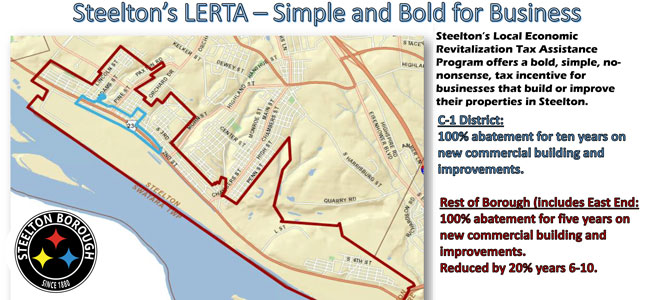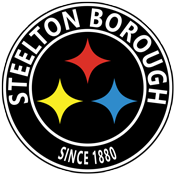Major tax incentive to spur economic development unveiled

A mix of retail, commercial, and residential space will soon take shape across from Steelton Borough Hall and new townhomes are also planned, assisted by an incentive giving property tax relief for new construction and renovation.
The Renaissance Row project across from borough hall will feature 80,000-square-feet of commercial space and 46 one- and two-bedroom apartments in three, three story buildings. Additionally, groundbreaking on 12 affordable townhomes on Adams Street is planned for later this year.’’
“Providing property tax relief for new construction and renovation can make the difference between making it viable to move forward on a project,’’ said county board Chairman Jeff Haste. “By making development feasible, this incentive will lift up entire neighborhoods.’’
Steelton Mayor Maria Romano Marcinko thanked the Commissioners, Borough Council and the Steelton-Highspire School District board, who all had to approve the incentive. The property tax relief applies only to higher levies that would result from improvements – owners will still pay taxes at the pre-improvement rate.
“Like manufacturing towns across the country, Steelton has struggled and it can be a challenge to convince developers to invest in our borough’s future,’’ Marcinko said. “Once we have a critical mass of successful projects further growth will follow and offering tax abatement will give us that critical mass.’’
Borough officials hope to attract a supermarket as part of the Renaissance Row project – filling an unserved need in the borough and a critical quality of life issue.
Under the LERTA — Local Economic Revitalization Tax Assistance Program – work done in the downtown commercial district along Front Street, between Conestoga Street to Strawberry Alley and in the 100 block of Adams Street, is eligible for 10 years of property tax relief.
New construction or renovation done elsewhere in the borough is eligible for reduced property taxes over nine years. Under the plan, property outside the commercial zone can receive 100 percent abatement for the first five years, 80 percent in year six; 60 percent in year 7; 40 percent in year 8; and a 20 percent break in year nine before paying the full amount on improved properties in year 10.
“In this case the saying, ‘You have to spend money to make money’ holds true,’’ said County Commissioner Mike Pries. “While the county, borough and school district will give up some tax revenue in the short term, the gain to the community and long-term gain to the tax base far outweighs the incentive we’re giving developers and property owners.’’
For the Renaissance Row project, the county also used $7,000 of a $400,000 federal Environmental Protection Agency grant to conduct an environmental assessment of the roughly 6-acre site, which had been part of the steel mill. The evaluation was essential in giving the developer, Philadelphia-based Chariot Companies, the assurance they needed to move forward with the project.
County Commissioner George P. Hartwick, III, who served as Steelton’s mayor, said he was excited to see the progress taking place. While Hartwick was mayor, the borough acquired the property in the 100 block of Adams Street, but officials were unable to attract a developer until now. Similarly, the Borough pieced together the properties that will become the Renaissance Row development.
“I’m proud to be a Steelton native and I think this tax incentive program is one more way that we can help revitalize his great borough,’’ Hartwick said. “All gentrification begins with a few signature projects that show what is possible and become magnets that attract additional investment.’’
The Adams Street Townhouse Project will feature 12, three-bedroom townhomes selling at below-market rates of $95,000 to $100,000 to qualifying buyers. The Tri-County Housing Development Corporation is the developer and the bank selected by the authority to help finance the project will also assist qualifying buyers with mortgages.
Construction is expected to cost as much as $135,000 per home and to reduce the selling price the county commissioners approved using almost $200,000 in federal housing funds and $125,000 in gaming grants to subsidize a portion of the cost.
“The Adams Street project underscores this board’s commitment to better the lives of our residents,’’ Hartwick said. “Not only will this create a strong neighborhood, but the Renaissance Row project, which is creating new commercial opportunities, will bring jobs to this community.’’
More Information
